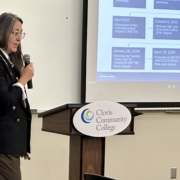CVHEC ‘Dual Enrollment Convening – the Central Valley Way’ Feb. 3
CVDEEP Task Force convening for
educators in 10-county region to look at
strategic planning, policy changes, student success and equity
The Central Valley Dual Enrollment for Equity and Prosperity (CVDEEP) Task Force Convening will be held Feb. 3, 2025 in Fresno where educators will resume discussions of challenges and barriers to dual enrollment success in the valley’s 10-county region.
Registration is now available for the free event presented by the Central Valley Higher Education Consortium from 10 a.m. to 3 p.m. at the DoubleTree Hotel in downtown Fresno. Breakfast and lunch will be provided to participants.New this year will be a pre-conference session from 9-10 a.m. that will provide information for high schools and colleges new to dual enrollment.
The event, postponed from November, will focus on creating a strategic plan for dual enrollment in the Central Valley, policy changes, support, student success and equity, said Dr. Benjamin Durán, CVHEC executive director.
“The dual enrollment opportunity provides a timely gateway to meaningful careers with sufficient earnings to support a quality of life for themselves and their families,” said Durán, who also is president-emeritus of Merced College.
Through dual enrollment, high school students earn college credits while earning their high school diploma which increases their chances of earning credentials, associate degrees and bachelor’s degrees as expeditiously as possible. Since 2019, the region has reported the highest share of community college students simultaneously enrolled in K-12 schools of any region in the state.
Durán said at this convening, college and university professionals will highlight their work delivering college level courses to high school students from rural high schools using an online dual enrollment strategy as a vehicle to reach populations that do not typically have the opportunity to benefit from taking college level courses while still in high school.
“This is a great way to infuse equity and inclusion into our partner institutions for those students who will benefit from getting a jump-start on gateway college courses that are essential for the successful completion of their degrees and certificates,” Durán said.
CVHEC created the CVDEEP Task Force — made up of community college and K-12 educational leaders — in July 2019 at the request of community college administrators so Central Valley colleges and K-12 partner districts could purposefully and strategically engage on a regional basis to deliver dual enrollment in a more equitable way.
The first two CVDEEP Task Force convenings in 2020 and 2022 set the stage for educators in the valley to collaborate leading to such gains as improving the CCCApply application process to the California Community College system and getting more high school teachers qualified to teach dual enrollment college courses.
For more information about the convening, contact Ángel Ramírez, director of operations and finance, at angelr@csufresno.edu or 559.278.0576.
CVHEC media contact: Tom Uribes • cvheccommunications@mail.fresnostate.edu • 559.348.3278 (text message)
Press release available at https://cvhec.org/cvdeep-task-force-sets-dual-enrollment-convening-nov-14-for-educators-in-10-county-region/
BACKGROUND: CVHEC Dual Enrollment White Paper sets the stage
In 2016, a new dual enrollment option was introduced through Assembly Bill (AB) 288, amending Education Code (EC) 76004, and creating the College and Career Access Pathways (CCAP). This legislation enabled more high school students to take college courses taught by college professors on their high school campuses. California AB 30, signed by Governor Newsom in October 2019, expanded and protected dual enrollment through 2027.
In June 2020, CVHEC released a 16-page report, “Dual Enrollment in the Central Valley, Working Toward a Unified Approach for Equity and Prosperity;” by former CVHEC Strategies Lead Virginia Madrid Salazar, Esq., that highlights this work and provides a blueprint to strengthen dual enrollment delivery in the Central Valley. (See her February 2022 CVHEC newsletter blog).
The task force’s first planning meeting July 22, 2018 brought together about 60 front-line educators who deliver dual enrollment services valley-wide to join forces establish a regional consensus that provided the direction for a full conference March 5, 2019.
At that first full convening in 2019, attendees representing 52 school districts, 12 community colleges and two education organizations/agencies spent the day in two panels and three breakout sessions discussing their experiences and ways to navigate forward.
John Spevak, a CVHEC regional coordinator, at the time commended the educators for their efforts in developing dual enrollment programs, telling his audience, “I’m just impressed with the amount of work that we have to do to make this successful. It just doesn’t happen by itself. This is one of the most intensive activities I have ever seen take place between high schools and colleges.
The second convening March 17, 2022, with the theme “Establishing Dual Enrollment Pathways in the Central Valley,” attracted more than 150 secondary and postsecondary educators to discuss and recommend action that has come into fruition as a result of their efforts :
- Improvements in the CCCApplyapplication process to the California Community College system.
- The Dual Enrollment Upskilling Teachers Master’s Program that provides access to state funding through the Fresno K-16 Collaborative providing funds for high school English and math teachers to earn their master’s degrees.






























